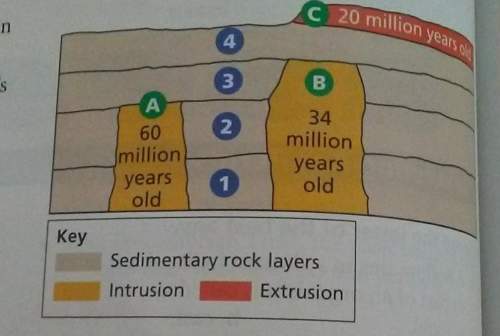
Biology, 06.07.2019 10:20 Billyr9088
The question is: what is the relative age of layer 3? (hint: with what absolute ages can you compare it? )


Answers: 1


Another question on Biology

Biology, 21.06.2019 19:00
Which describes how weathering and erosion are different? weathering is caused by water. erosion is caused by wind and ice. erosion transports sediments. weathering is a natural process.
Answers: 1

Biology, 21.06.2019 20:30
The collared lizard is a species found in the desert southwest. male collared lizards show considerable color variation, ranging from brightly colored to a very dull pattern. your goal is to determine the function, if any, of male color patterns in collared lizards, using the scientific method. your tentative explanation is that male color plays a role in attracting females for mating purposes. you predict that females will preferentially choose brightly colored males over dull-colored ones. to test this prediction, you observed the interactions of female collared lizards with their male counterparts. you selected males that were the same age and size, and that differed only in their coloration pattern. you placed equal numbers of the two types of male lizards, bright and dull, in aquariums, along with one female lizard per aquarium. out of 350 aquariums observed, the female chose to mate with the brightly colored male 277 times, and the dull-colored male 70 times. in 3 instances, the females did not mate with either type. create a bar graph of your data, plotting the type of male (dull or brightly colored) on the x-axis. on the y-axis, plot the frequency with which each type of male was chosen by females. using this graph, answer the following question(s). is it reasonable to conclude (i.e., is it supported by the data) that female collared lizards prefer more brightly colored male lizards over dull-colored males?
Answers: 3

Biology, 22.06.2019 08:00
Drag each label to the correct location in the equation. not all tiles will be used. the density of mercury is 13.6 grams per cubic centimeter. complete the steps for converting 13.6 g/cm3 to kg/m3. (1 kg = 1,000 g, 1 m3 = 106 cm3)
Answers: 3

Biology, 22.06.2019 11:00
In the united states there are strict fishing seasons and limits, but not all countries enforce similar laws. in bangladesh there are few if any fishing restrictions. what might be the reason for less restrictions in smaller countries like bangladesh? a) the united states is the only country worried about overfishing. b) the united states wants to limit the supply of fish to increase the price. c) bangladesh and smaller countries have an unlimited supply of fish in their coastal waters. d) small countries, such as bangladesh, are practicing subsistence fishing, taking only the fish needed to survive.
Answers: 1
You know the right answer?
The question is: what is the relative age of layer 3? (hint: with what absolute ages can you comp...
Questions





Biology, 01.07.2019 08:00







Physics, 01.07.2019 08:00


Mathematics, 01.07.2019 08:00

Mathematics, 01.07.2019 08:00



Mathematics, 01.07.2019 08:00

History, 01.07.2019 08:00

Mathematics, 01.07.2019 08:00



